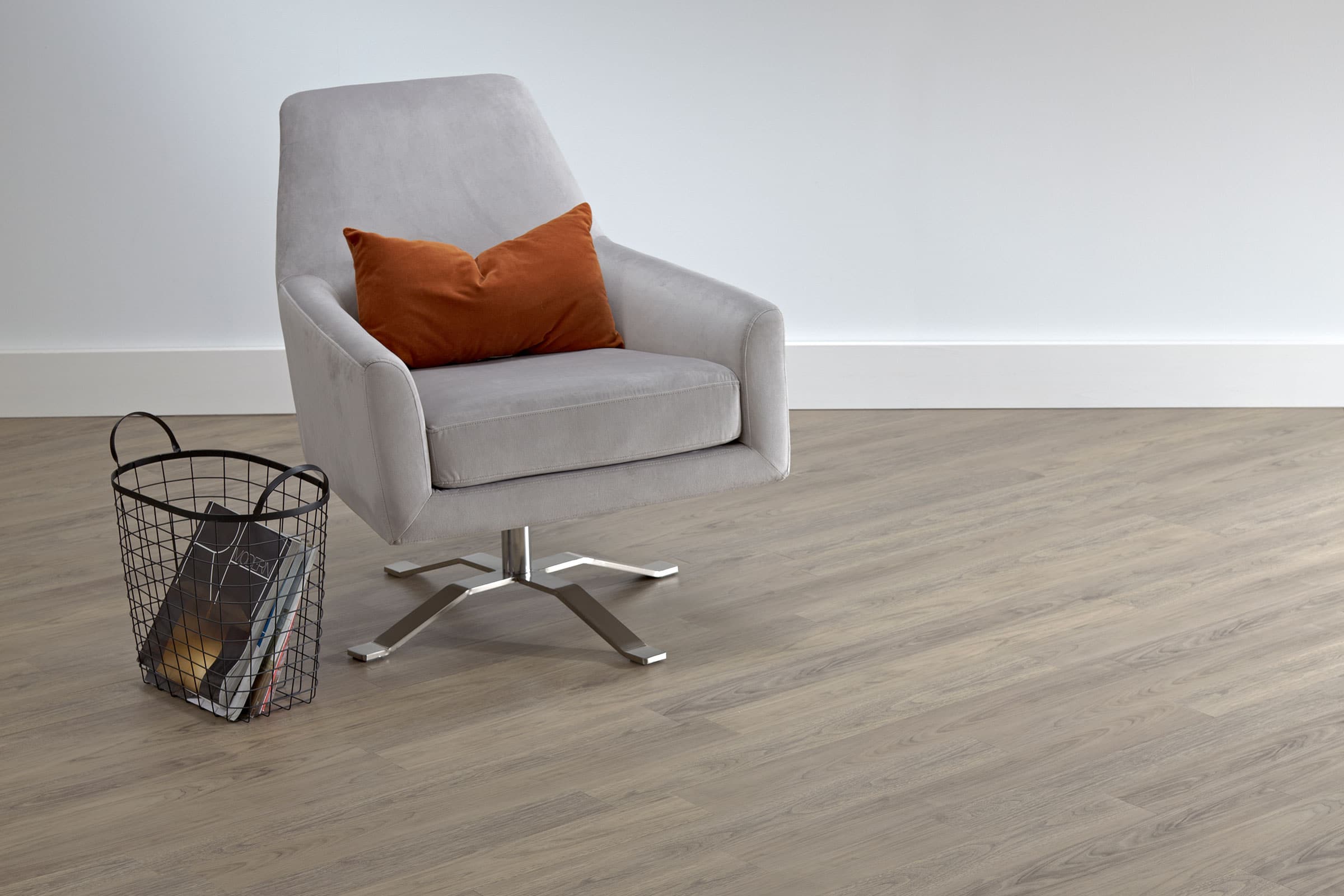Story at a glance:
- Discover green flooring options in carpet, terra-cotta, bamboo, and more.
- The US has a number of sustainable carpet tile manufacturers to choose from.
- Flooring that is low in VOCs and easy to clean continues to be important in health care settings.
Interior design that is environmentally friendly is on the rise, including demand for green flooring products, according to the American Society of Interior Designers.
From incorporating green building materials in the initial design to filling projects with furniture from sustainable companies, what may have once been a trend shows no sign of slowing down. And when it comes to green cleaning products, the global green cleaning products market accounted for $3.9 billion in 2019 and is estimated to reach $11.6 billion by 2029, according to Prophecy Market Insights.
But how good is the interior design if you don’t start from the ground up—with sustainable flooring? Just think of all the time you spend on your feet or, if you have kids and pets, how close they can be to the ground. What’s under your feet matters, whether you’re inside the house or spending much of your time in what you hope is a healthy office.
This is a quick guide to some of the top green flooring products out there, from actual flooring materials to the products you clean floors with.
What Makes Flooring Products Sustainable?
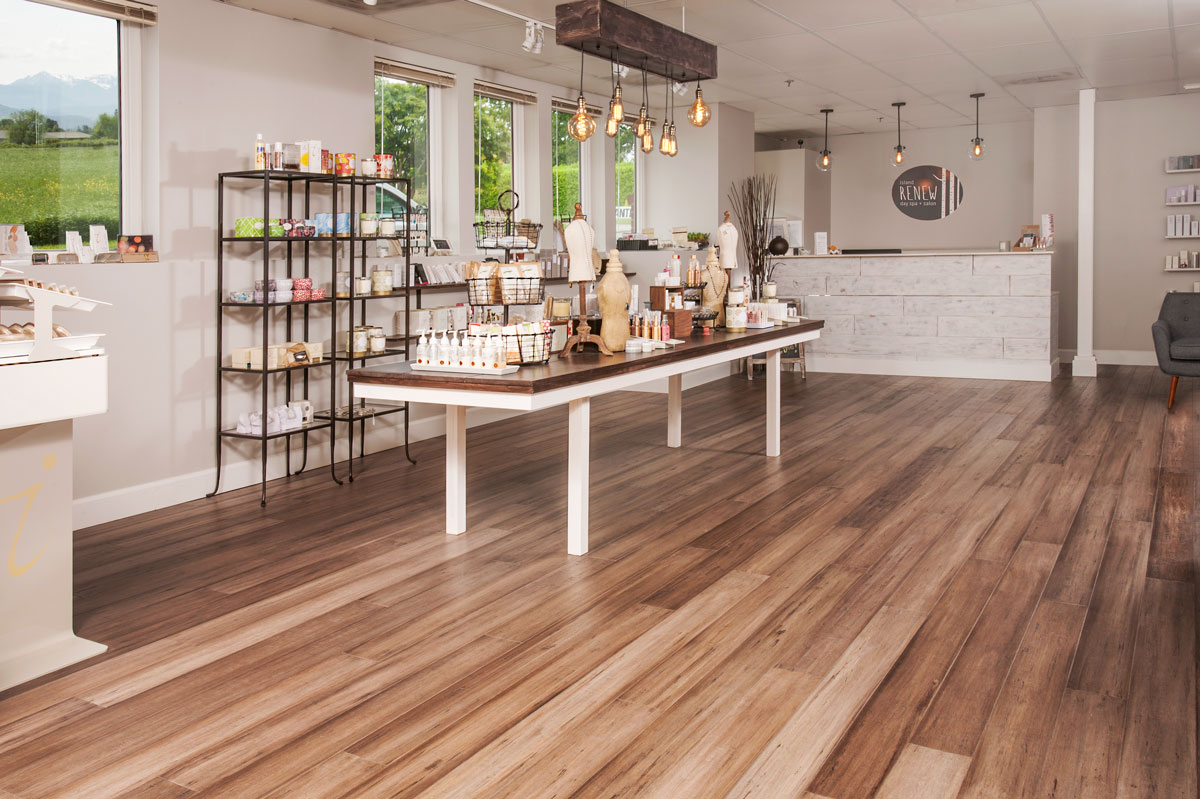
Responsible material sourcing, use of nontoxic ingredients, and an environmentally-friendly manufacturing process are all hallmarks of green flooring products. Photo by Roger Turk, Northlight Photography
Before we actually start exploring the world of green flooring products, let’s take a moment to talk about what qualities make flooring products sustainable in the first place.
Material Sourcing
Sustainability starts with the responsible sourcing and procurement of raw materials used to manufacture flooring products. If these materials are organic, it means they are cultivated and harvested in such a way that does not negatively impact the environment or local communities—and if they are inorganic, it means that they are mined with minimal impact on surrounding ecosystems and their quarries do not make use of unethical labor practices.
In the event that the raw materials are synthetic in nature—like the plastic fibers used to manufacture most modern carpets—they should be obtained via recycling programs to prevent undue greenhouse gas emissions.
Nontoxic Ingredients
It’s not enough for a company to source their materials ethically, however. They must also take measures to ensure that all (or at least large majority) of the materials and ingredients used in their flooring products are nontoxic and safe for the environment.
One of the most effective ways to verify that flooring products are free of toxic ingredients is to look for product Declare labels and health or environmental product declarations. A Red List–free label, for instance, signifies that a product does not contain any ingredients on the International Living Future Institute’s Red List, a comprehensive guide to the so-called “worst in class” chemicals and compounds known to cause human and environmental harm.
Manufacturing Process
Even if a company uses responsibly sourced, nontoxic materials and ingredients in their products, that early commitment to sustainability means very little if those products’ manufacturing processes consume large amounts of energy and resources or generate high levels of greenhouse gas emissions.
Companies that manufacture green flooring products can provide tangible, verifiable third-party reviewed evidence as to their efforts to reduce manufacturing emissions.
Companies that manufacture green flooring products can provide tangible, verifiable third-party reviewed evidence as to their efforts to reduce manufacturing emissions (e.g. integration of renewable energy), water use (e.g. through wastewater recycling), and/or waste production (e.g. the collection and reuse of wasted material for use in new products), et cetera.
An Expert’s Guide to Green Flooring Products
When people hear the words “green flooring,” chances are stone or timber come to mind—and while they are some of the oldest examples of green flooring products, they are far from the only ones.
Broadloom Carpet & Carpet Tiles

Aquafil works closely with its customers on a concept they call “Born R2R,” or born regenerated to be regenerable, to encourage them to create products with eco-design in mind. Photo courtesy of Aquafil
Generally speaking carpet isn’t the most sustainable option when it comes to flooring, as most modern carpets are made from synthetic plastic fibers like polyester, nylon, or polypropylene that take thousands of years to break down. Of course, some companies still prefer to use natural materials like wool, cotton, jute, and so forth, but these are few and far between.
However, the durability of plastic fibers also means they may be recycled multiple times without experiencing a decline in quality. In an effort to reduce their environmental footprint, many flooring manufacturers have started incorporating recycled materials—like ECONYL—into their carpet products.
ECONYL is a high-quality regenerated nylon material produced by Aquafil using recycled plastic waste from discarded carpets and fishing nets. “Resilient design goes with the quality of the product. When we produce ECONYL, we use waste to produce it, but the way we produce it through chemical recycling, not mechanical recycling, gives us the possibility to keep the quality of nylon as good as if it was coming from crude oil or as good as nylon used for the first time,” Gaëlle Merlin, design and development manager at Aquafil, previously told gb&d. “ECONYL is not only a 100% regenerable product, but it’s also a product of first choice quality. It’s made to last.”
When it comes to carpeted floors, there are two basic choices: traditional broadloom rolls and carpet tiles. Both have their advantages but the ease of installation and versatility of the latter has led to their becoming an increasingly popular choice in commercial projects.
Bentley Mills

Photo courtesy of Bentley Mills
Bentley Mills was the first manufacturing facility in the US to be LEED-certified, and their carpet products continue to be produced in California, earning them a number of certifications and green labels. Today they have products in a range of colors across commercial projects, from the “non-solid solid” Color Core to the multi-faceted and textured Off the Chain.
“Off the Chain is based on embroidery and chain stitching,” Ginger Gilbert, vice president of product design and development at Bentley Mills, previously told gb&d. “We were looking at knitting and work done by hand. We wanted to create a feel that was fairly low in ounce weight but that also brought a feeling of warmth into a space.”
She says that’s especially important considering how more buildings are dominated by glass but also living green walls. “Plants are coming back into spaces,” she says. “They’re a design element we need to work with, creating more textures versus patterns where people are trying to mimic the outside. We’re supporting the outside in bringing that texture and warmth to a space.”
Tarkett
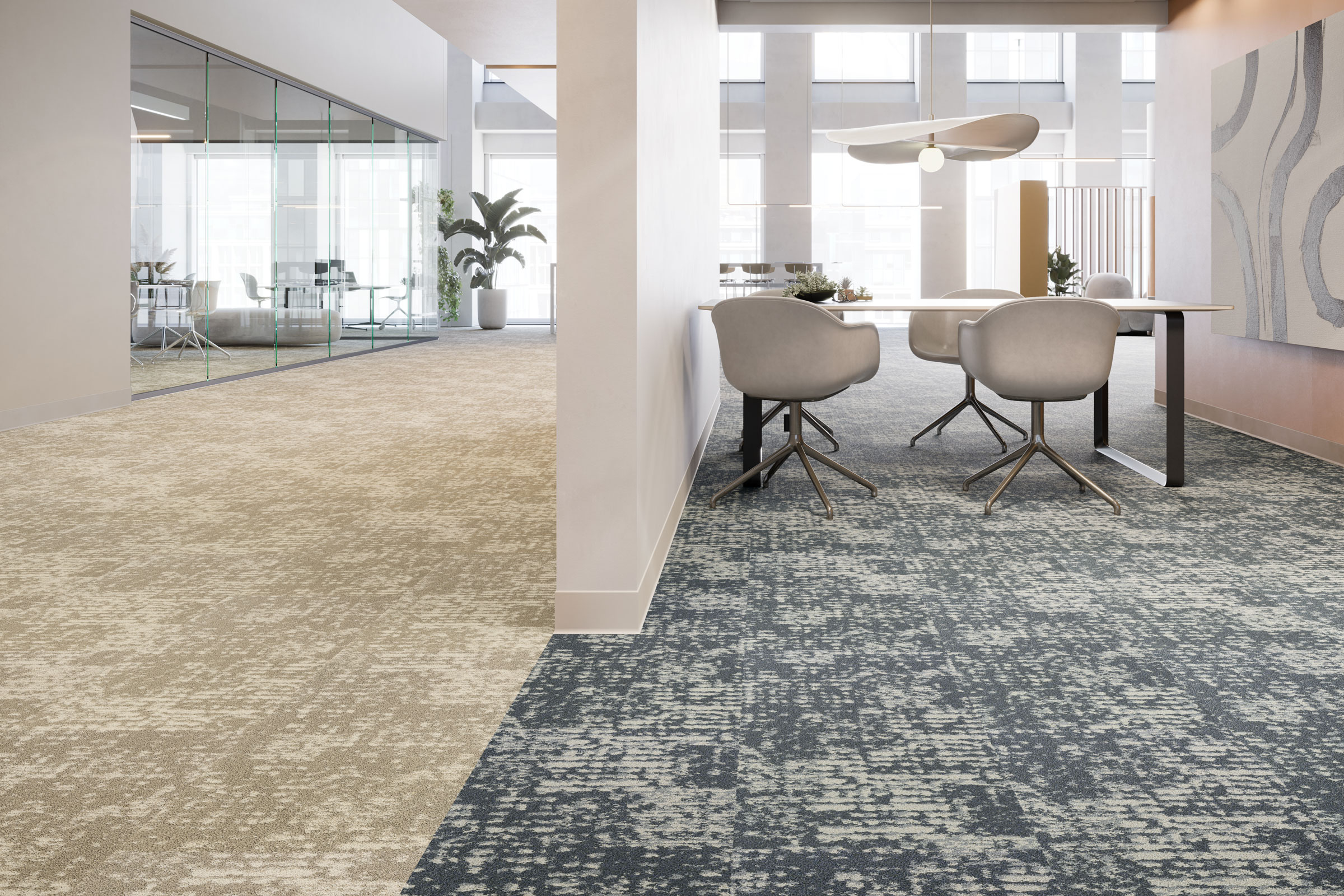
Photo courtesy of Tarkett
Tarkett is another flooring manufacturer committed to sustainable carpeting. In one Oregon project the design team installed Powerbond, a resilient solution that is 100% recyclable and promotes healthy indoor air quality. The hybrid sheet flooring allows for colorful inlays that add a whimsical element to projects like school design. For school officials in Oregon, there were bottom line benefits, Jonathan Klinger, chief marketing officer for Tarkett North America, previously told gb&d.
This Tarkett flooring both resists soil entrapment and masks wear, reducing maintenance costs. And for cost-conscious administrators, a long-lasting product is simply good business. “If they know they can install a product that’s going to last 50 years, then that provides them an economic peace of mind they would not find in an alternative product,” Klinger says.
Mohawk

This New York City showroom shows off some of Mohawk Industries’ most beautiful flooring products. Photo by Garrett Rowland
For other carpet tile options, Mohawk’s Relaxing Floors Collection is a patterned Living Product based on research linking fractals to stress reduction. These repeating, organic patterns are found throughout nature, and the carpets capitalize on the same concept. “It’s random. Nature is random. It is no different than you seeing branches on a tree or leaves on the ground or sand on the beach. And there’s a certain level of relaxation that comes with that,” Mohawk Flooring North America’s chief sustainability officer previously told gb&d.
Luxury Vinyl Tile
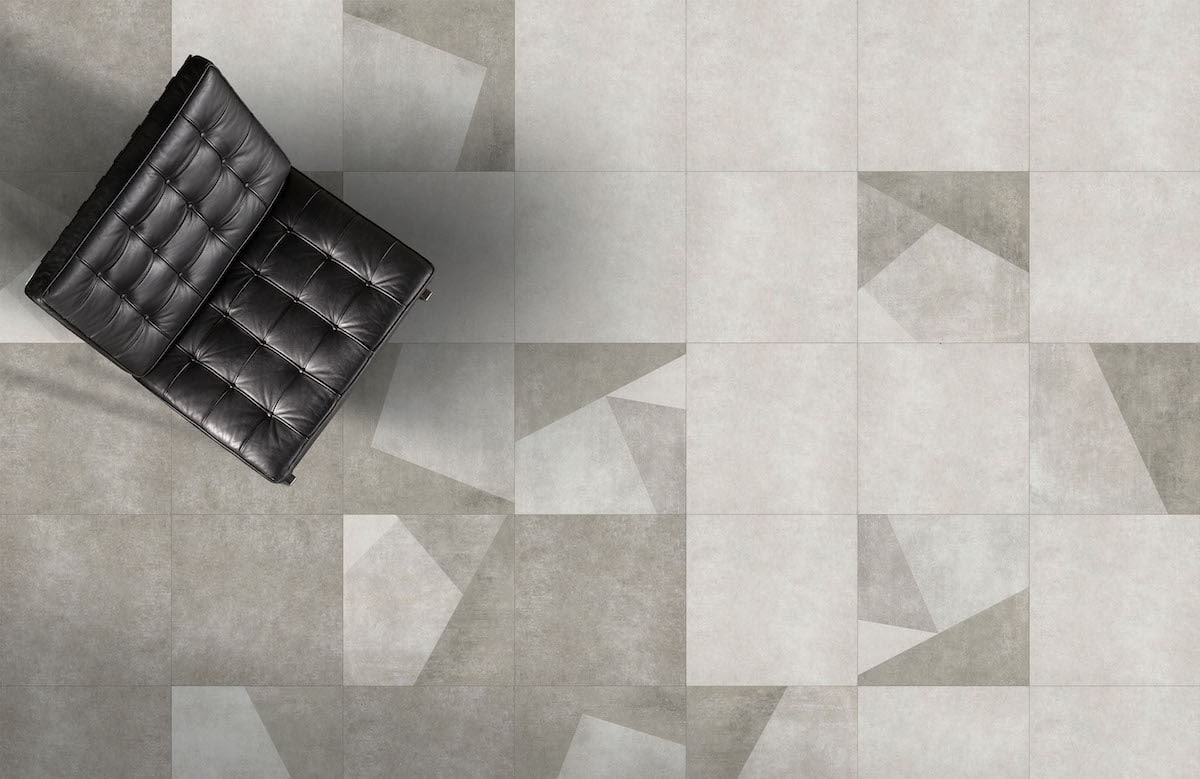
Photo courtesy of Metroflor
Luxury vinyl tile (LVT) or luxury vinyl plank (LVP) is a type of flooring designed to realistically mimic the appearance of stone, wood, marble, or other natural materials. It is an ideal flooring option for those who want the look of natural materials but don’t want the high upfront costs or maintenance requirements that typically come with said materials.
“Especially for a building owner, LVT is a very easy product to put in because of its low maintenance. And it’s hard to damage,” Sean Brennan, US president of Kährs, told gb&d in a previous article. “It’s a good alternative to carpet. It’s easier to clean, it has some water-resistant features, and can be less expensive than other flooring alternatives.”
One of the problems with conventional LVT, however, is its use of ortho-phthalate plasticizers, a variety of chemicals intended to increase durability and flexibility but which do not form bonds with plastic but instead have a tendency to leach out of products over time. These chemicals then contaminate dust and air in indoor spaces, where prolonged exposure can cause reproductive issues and lead to impaired brain development.
Metroflor
US-based Metroflor was the first major LVT manufacturer to eliminate ortho-phthalate plasticizers from its resilient flooring products. “It’s the right thing to do—for our planet, our people, our users, and our manufacturers,” Harlan Stone, CEO of HMTX Industries, which includes Metroflor, said in a previous interview with gb&d. All Metroflor flooring products are third-party certified as having low VOCs through FloorScore, and their entire Aspecta line, with more than 200 designs, has Declare labels and Health Product Declarations.
Natural Stone Tile & Terrazzo
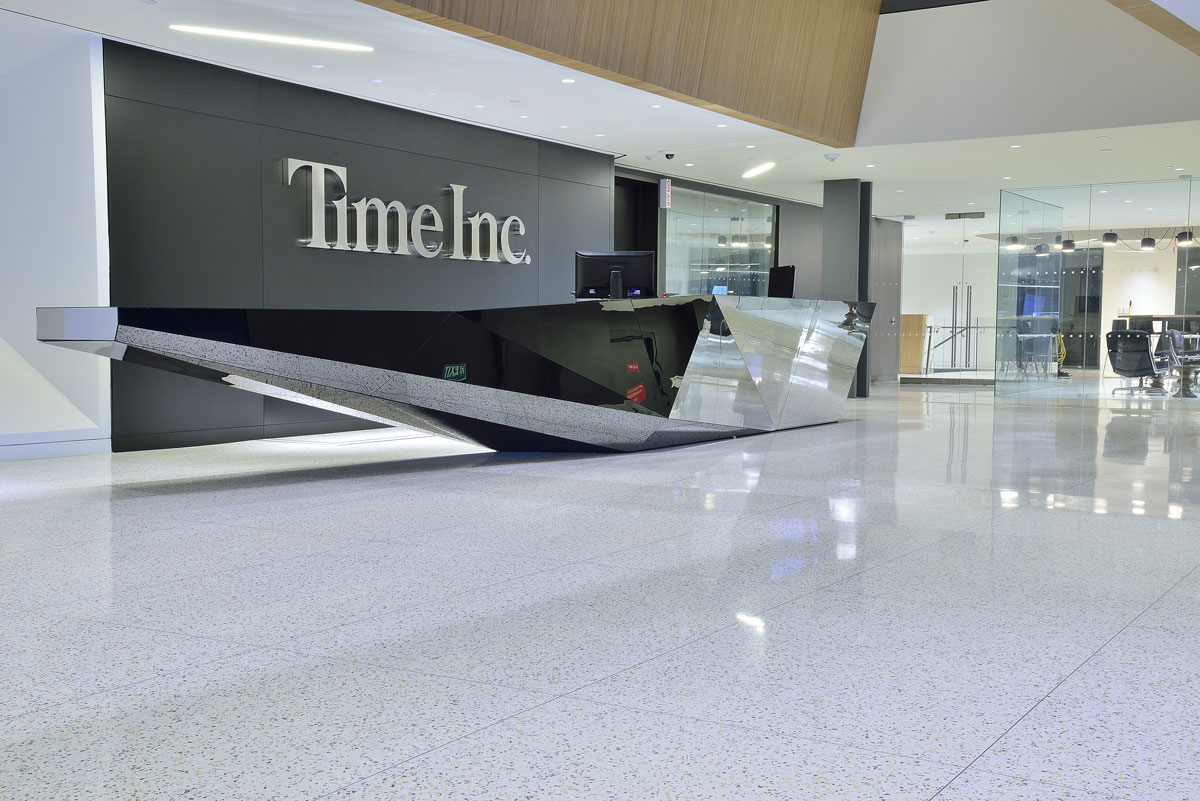
Terrazzo’s durable floors can be seen all over—from Time Inc.’s headquarters to Phoenix Sky Harbor International Airport. Photo courtesy of Terrazzo & Marble Supply Companies
Stone is one of the oldest environmentally friendly flooring options on the market—and for good reason: it’s strong, durable, and aesthetically pleasing while also being incredibly practical and low-impact. “Stone has an extremely low embodied carbon footprint because it was formed by the planet itself,” Hugo Vega, vice president of commercial and institutional sales at Polycor, told gb&d in a previous article.
In addition to stone’s low carbon footprint, natural stone quarries have a minimal impact on the environment, as they do not use chemicals in their operation—meaning no soil remediation is needed after the fact. “It’s a hole that will be filled when the quarry reaches its end of life, and nature will take its place because it’s not polluted,” Vega says.
While quarries often produce a large amount of scrap stone ill-suited for use as tile flooring, that scrap can be repurposed in a variety of ways, such as in the form of terrazzo flooring. Originating in Italy, terrazzo is a composite material traditionally consisting of marble, quartz, and/or granite chips cast in a cementitious binder. Like stone, terrazzo flooring is extremely durable, long-lasting, and has low maintenance requirements.
Polycor
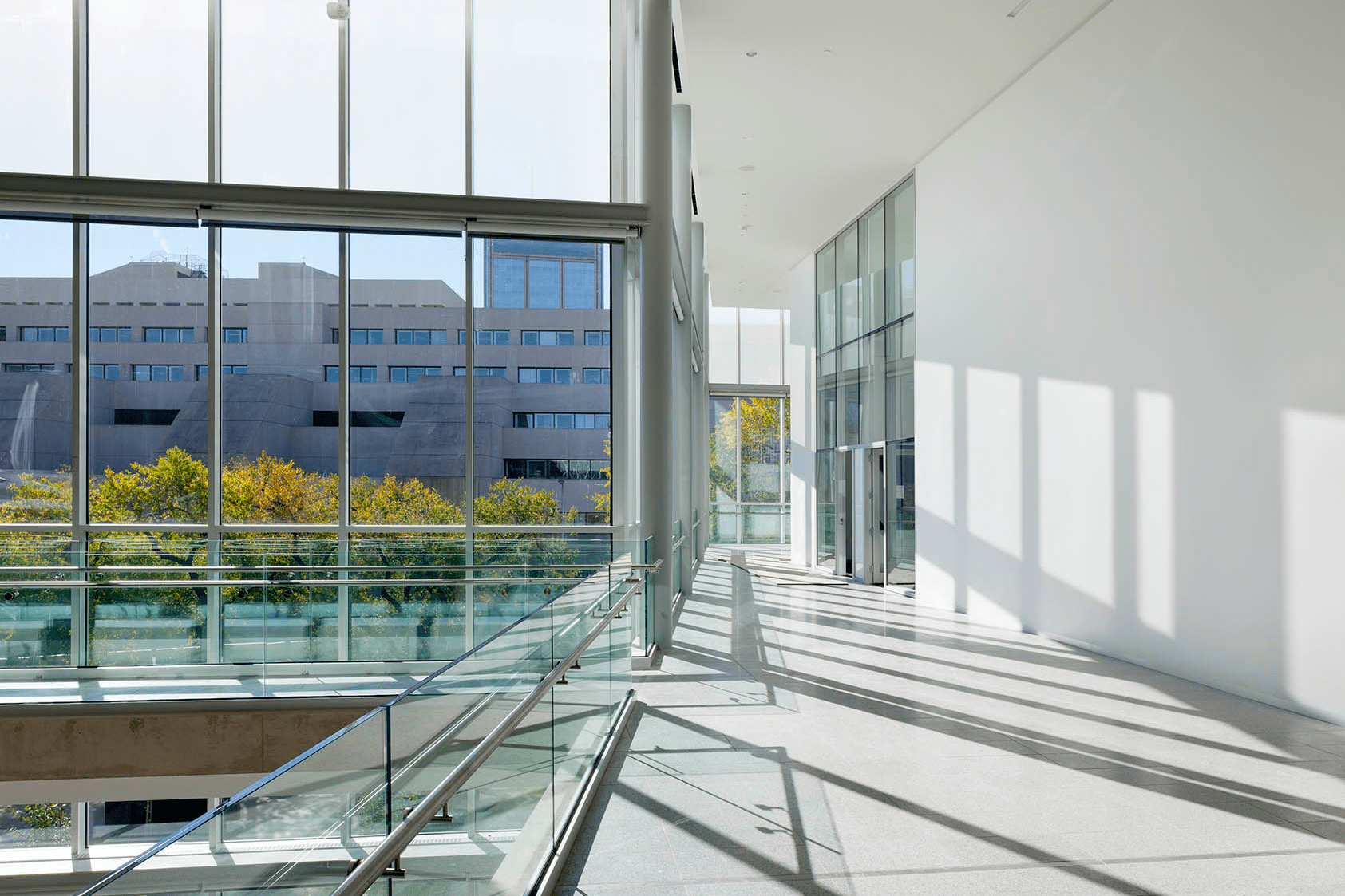
The Royal Alberta Museum in Edmonton received a Tucker Design Award from the Natural Stone Institute in August 2020. Designed by architecture firm DIALOG, this project used Polycor’s Indiana limestone in standard gray. Photo courtesy of Polycor
As the world’s leading natural stone quarrier, Polycor is under intense scrutiny when it comes to sustainable business practices. That’s why 14 of their sites are certified under the ANSI/NSI 373: Sustainable Production of Natural Dimension Stone standard, which “sets out requirements for responsible environmental and social practices in natural stone production.”
Polycor’s NSI 373 Certified sites take measures to lower water usage, ensure unbroken ownership from quarry to end user, responsibly manage their environmental impact, source and ship materials efficiently, manage necessary chemicals safely, sustainably reclaim quarry sites after use, and more.
To avoid issues with child and slave labor—common problems in the overseas stone industry—Polycor sources all of its stone from North America. “You have to understand where the stone is coming from,” Vega says. “Many years ago people started drinking organic Fair Trade coffee, and now it’s common for people to ask for such a product, but there’s an equivalent in the natural stone industry when it comes to where the product is coming from and the working conditions of the people who quarry the stone. When you buy local stone quarried in America or Canada it’s a Fair Trade product.”
Terrazzo & Marble Supply Companies

The Duke Ellington School of the Arts in DC features poured-in-place epoxy terrazzo. Photo courtesy of Terrazzo & Marble Supply Companies
North America’s leading supplier of terrazzo flooring solutions, Terrazzo & Marble Supply Companies, goes above and beyond in ensuring that all of their products are sourced and manufactured with as minimal an impact on the environment as possible. The company has a centralized manufacturing facility located in the Midwest and offers a variety of regional marble aggregate chips in an effort to help reduce transportation-related emissions.
Many modern terrazzo manufacturers—Terrazzo & Marble included—have moved beyond stone as their only aggregate option, offering a range of recycled materials like porcelain, glass, and even beer bottles as aggregates. “We take a lot of things that would be put into the waste stream that we can reclaim and reuse in a terrazzo floor,” James Bateman, terrazzo division manager of Terrazzo & Marble Supply Companies, previously told gb&d.
And instead of casting those aggregates in cement—an extremely carbon-intensive material—Terrazzo & Marble Supply uses a proprietary epoxy resin called Terroxy, which they also manufacture. Terroxy is antimicrobial, offers a Class A Fire Rating, and is GREENGUARD GOLD–certified through UL Environment, meaning it is low-VOC and will not pose health risks to building occupants.
Terra-Cotta Tile

Native tile. Photo courtesy of MILE®stone
Similarly, ceramic and porcelain tiles are durable, low maintenance, and fire-resistant flooring solutions made primarily from clay terra-cotta, a highly-sustainable inorganic material with a low embodied carbon. Differing only slightly in their manufacturing processes, ceramic and porcelain tiles are created by firing a mixture of clay, minerals, and water at high temperatures—the resulting product is a non-porous, weather resistant, and long-lasting tile that can last upwards of 60 years.
This long life cycle allows the tiles ample time to offset the emissions produced during their manufacturing—though many companies are taking steps to make the production process cleaner. “Common sustainability efforts in the manufacturing process include high scrap recycling rates, use of offsite recycled material, water reuse, and efficient use of energy (natural gas and electricity),” Don Haynes, sustainability and environmental manager at Florim USA, previously wrote for gb&dPRO.
Florim
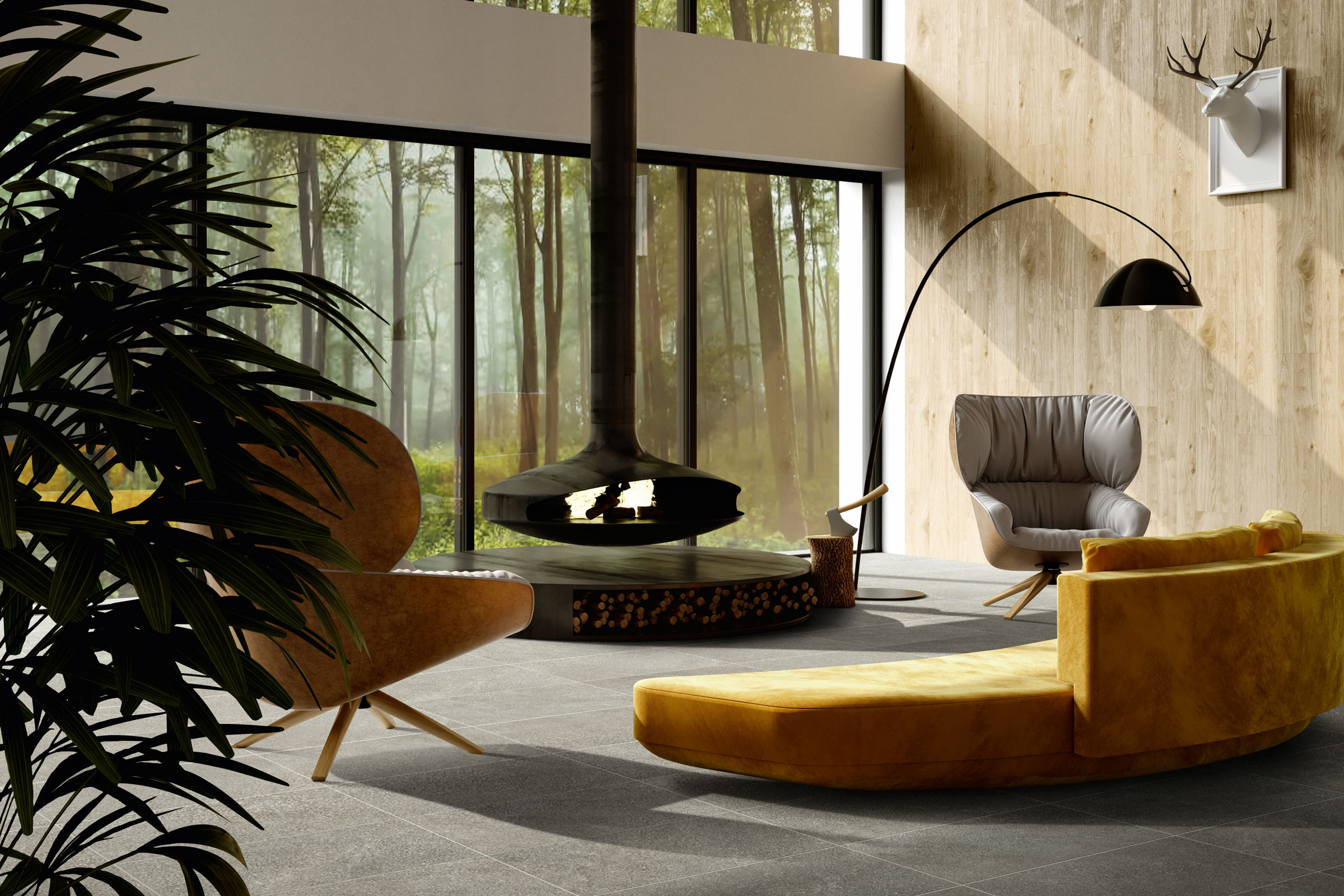
Photo courtesy of MILE®stone
Florim is one of the world’s foremost manufacturers of porcelain tiles and no stranger to sustainability. Each year the company internally recycles 99.9% of its materials and all water used during production is collected and reused in other processes, all but eliminating operational waste.
In 2022 Florim USA—which sells its products under the MILE®stone commercial brand name—became the first porcelain tile manufacturer in the world to earn the International WELL Building Institute’s WELL Health-Safety Rating. “The WELL Health-Safety Rating represents the company’s ongoing commitment to the well-being of our employees and customers,” Haynes said in a previous press release. “This intersects with Florim’s longstanding efforts and core values that places emphasis on health, safety, and the environment.”
All of Florim USA’s tile products are Red List Free, GREENGUARD-certified, and made from at least 95% non-carbon containing raw materials sourced within a 500-mile radius of their Tennessee production plant.
Ludowici
Ludowici is another leading manufacturer of terra-cotta tiles that, despite primarily specializing in roofing tiles, also offers several quarry tile flooring solutions. All of Ludowici’s terra-cotta tiles use locally mined clay and are 100% recyclable, energy-efficient, free of toxic and synthetic ingredients, and come with a 75-year material warranty.
That long lifespan is in large part thanks to the emphasis Ludowici puts on the clay body in all of its terra-cotta tile products. A weak clay body allows moisture to seep into the clay, increasing its susceptibility to freeze/thaw cracking—but all of Ludowici’s clay body is run through filters to ensure quality before being fired at high temperatures and hardened into a durable, non-porous, glass-like material.
“We make our clay body dense enough that it doesn’t soak up water in the first place,” David Jensen, sample coordinator, glaze production scheduler, and color consultant at Ludowici, previously told gb&dPRO. “That’s something we take pride in because even though it may not be the most glamorous aspect of the tile, the clay body is really what lets our product last as long as it does in so many different environments.”
The company’s high-traffic institutional grade terra-cotta Promenade tiles—in use at both the White House and Rockefeller Center—for example, are available in two sizes (6”x 9” and 9”x9”), smooth and non-skid surfaces, and a range of custom colors, mists, and blends.
Hardwood

The Ardmore House in Chicago. Photo courtesy of Delta Millworks
Hardwood is one of the oldest flooring materials on the market and is considered sustainable thanks to trees’ ability to sequester carbon in their tissues and in the soil surrounding their roots. As long as it is sourced from responsibly managed new-growth forests—i.e. those that have been FSC-certified—hardwood is a solid green flooring solution that provides timeless aesthetics and impressive longevity when properly cared for.
Delta Millworks
Delta Millworks is one such company taking responsible sourcing extremely seriously. “We source sustainable wood out of tree farms in New Zealand or British Columbia, where they’re pulling out less than 1% of the standing trees every year and then regrowing them, so most forests there are expanding,” Robbie Davis, CEO of Delta Millworks, told gb&d in a previous article.
“We don’t touch tropical hardwoods coming out of the Brazilian rainforest. And there’s still some clear-cutting going on in Asia and Africa and other parts of the world, so we avoid those, too. Frankly, we think modified woods like Accoya, our most popular product, outperform them. It’s Radiata pine that takes about 28 years before it’s ready for harvest.”
Bamboo
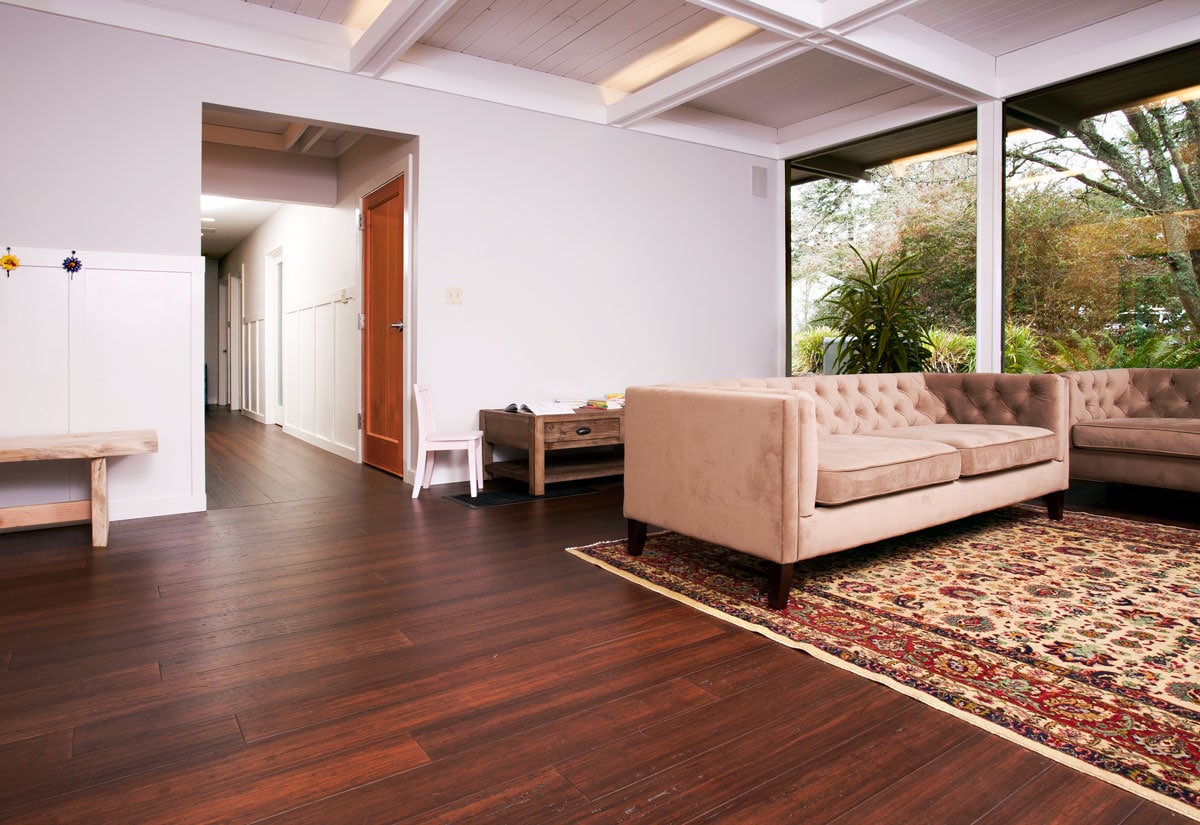
Strand bamboo—a type of bamboo—revolutionized the world of flooring, according to president of Trinity Bamboo, Tom Goodham. Photo by Roger Turk
Bamboo has served as a traditional flooring material in many Southeast Asian countries for many generations, but it has only recently started gaining popularity in Europe and North America. This is largely attributed to the material’s natural beauty as well as bamboo’s extremely fast growth and maturation rate.
Unlike hardwoods that take approximately 20 years to reach maturity, bamboo reaches its full height in as little as nine months and reaches maturity in just three to four years; after the first harvest, the same culm may then be harvested every four to six years. Its rapid regrowth means bamboo forests sequester more carbon than typical hardwood forests. When cultivated using traditional methods bamboo requires very little supplemental watering or fertilizing and does not require the spraying of pesticides for successful growth.
Bamboo can either be cut into slats and used as is, shredded and woven back together to create strand-woven bamboo flooring, or shredded and recombined to create fused bamboo planks.
Trinity Bamboo
Trinity Bamboo is one of those companies that specializes in stranded bamboo flooring, of which has a comparable hardness to tropical hardwoods like teak and mahogany, meaning it is incredibly durable and long-lasting.
“Strand bamboo is very difficult to dent, and, thanks to the screen and recoat refinishing process, has an almost unlimited life span in typical commercial or residential spaces,” Tom Goodham, president of Trinity Bamboo, said in a previous gb&d article. Strand bamboo combines the durability and dimensional stability of these tropical hardwoods with the green credentials of traditional bamboo flooring products.
Recycled Rubber
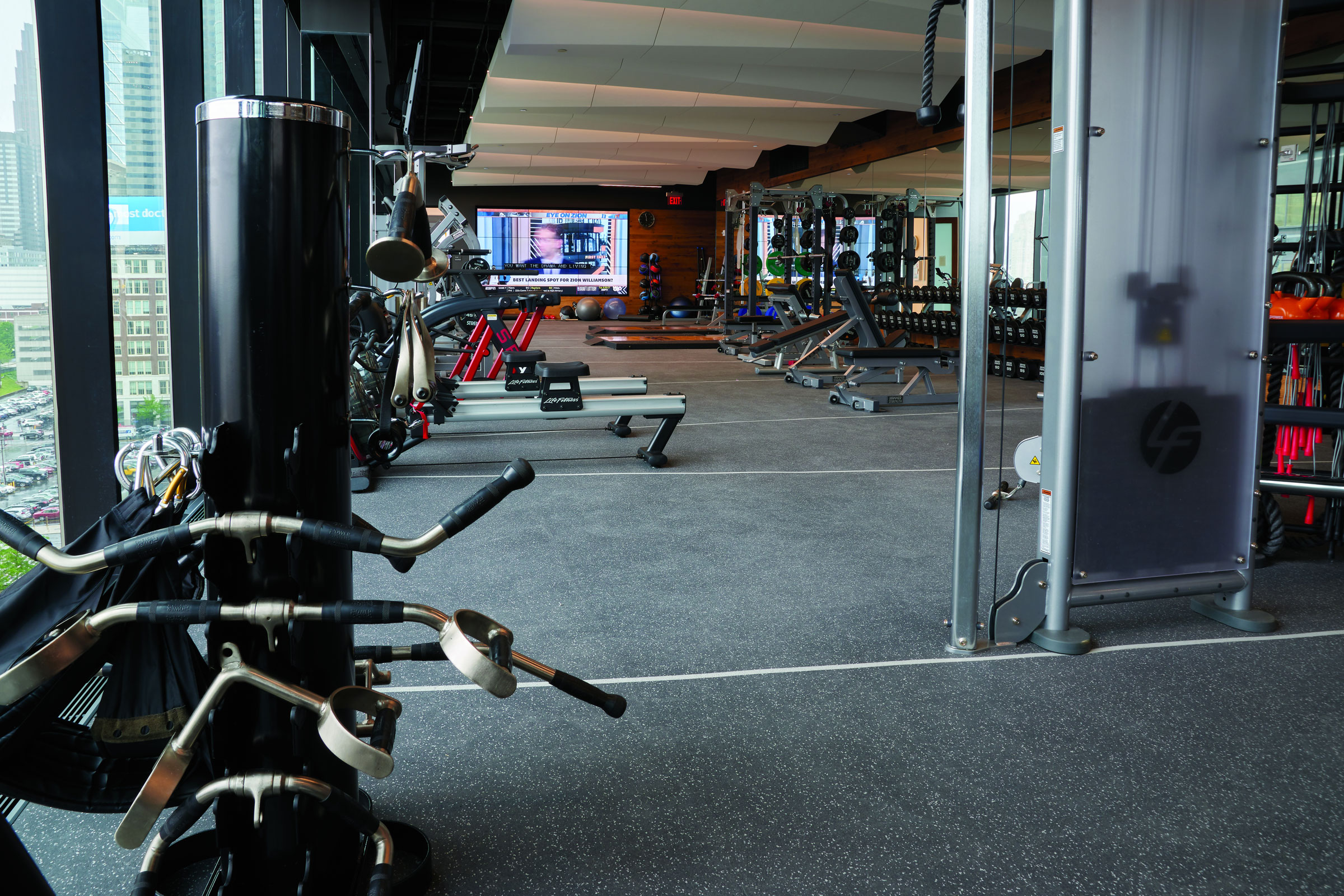
Photo courtesy of REGUPOL
LVT, stone, and hardwood are all excellent flooring materials suitable for a range of residential and commercial projects looking to reduce their environmental footprint, but they aren’t suitable for all projects. Sports facilities like gyms and arenas or educational institutions like schools and colleges, for example, require floors that can stand up to high foot-traffic, hard impacts, and intensive cleaning. In these instances, rubber flooring becomes the obvious option.
A natural material, rubber is derived from latex sap harvested from Hevea brasiliensis—or the Pará rubber tree—meaning it is both a renewable resource and a form of carbon sequestration. Historically, however, the cultivation, harvesting, and production of rubber has contributed significantly to deforestation, pollution, and the often violent exploitation of South American Indigenous peoples.
Fortunately, rubber is a highly recyclable material, with many modern flooring manufacturers choosing to utilize a large percentage of recycled rubber—such as that from reclaimed tires—rather than virgin rubber in their flooring products.
REGUPOL

Photo courtesy of REGUPOL
REGUPOL—a leading manufacturer of rubber products—has you covered with an array of green flooring options. Seven of their product lines, including their sports flooring, were recently added to the mindful MATERIALS (mM) library, a free platform with aggregated information on human health and environmental impacts for products from leading manufacturers. The material ingredients, EPDs, and emission data testing for each REGUPOL product is readily accessible to visitors of the library.
REGUPOL offers top-notch track and field surfaces that provide superior traction, uniformity, and comfort while meeting stringent performance standards under IAAF guidelines. The company uses more than 115 million pounds of recycled rubber in its manufacturing process. REGUPOL America uses 100% post-consumer tire rubber, post-industrial EPDM rubber, and additional renewable resources.
Roppe
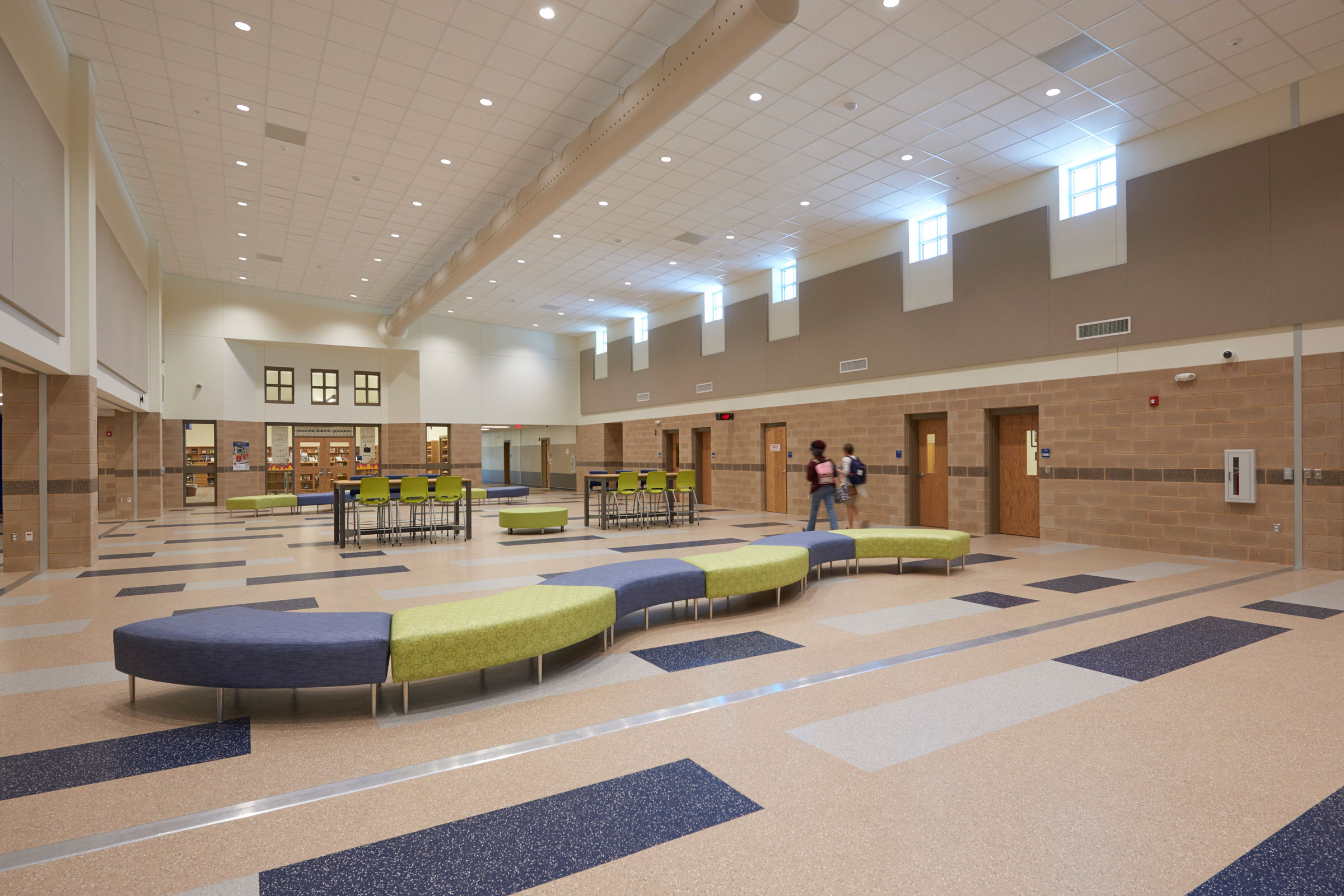
The design of rubber flooring has evolved greatly over the years to be a great fit for educational spaces. The Pearson Ranch Middle School in Austin features Roppe flooring, shown here. Photo courtesy of Roppe
Roppe is another industry leader when it comes to rubber flooring solutions, one that has demonstrated a long-time commitment towards green operation through environmental product declarations and aggressive sustainability goals. “We continue to strive for improved processes that result in a reduction of greenhouse gasses, energy intensity, and landfill waste while increasing our waste conversion into sellable products,” Dee Dee Brickner, marketing manager at Roppe, previously told gb&d.
Another indicator of Roppe’s green manufacturing practices is their rubber tile’s status as a Red List Free product, achieved in large part through the elimination of factory applied permanent coatings. These coatings are used to improve the durability of high performance rubber floors but are also a common source of known toxic chemicals that can cause skin irritation and rashes when mishandled.
“Our ownership chose not to apply permanent surface coating on rubber flooring products, opting to reformulate them instead in a way that a wear layer will not be required to deliver product performance,” Rahul Dhavalikar, director of product development at Roppe, wrote in a previous gb&d article. “As a result, we have Red List–free rubber flooring products. Not having this coating also means the customer saves money in the long term—they don’t have to maintain the coating or re-apply to maintain original durability.”
Thanks to their lack of harmful ingredients, Roppe’s rubber tiles are a perfect fit for educational institutions that require highly-durable floors without sacrificing indoor air quality and student health in the process.
Health Care Flooring

Teknoflor’s sheet products offer heat-welded, seamless installation for easy cleaning and infection control. Photo courtesy of Teknoflor
And while we’re on the topic of projects that require more specialized flooring solutions, let’s talk about the category of development with perhaps the most stringent performance requirements of all: health care spaces. These buildings require flooring products that are environmentally friendly, durable, resilient, and easy to clean while still being comfortable and aesthetically-pleasing.
Some companies that offer green, high-performance flooring products suitable for use in health care spaces include:
Teknoflor
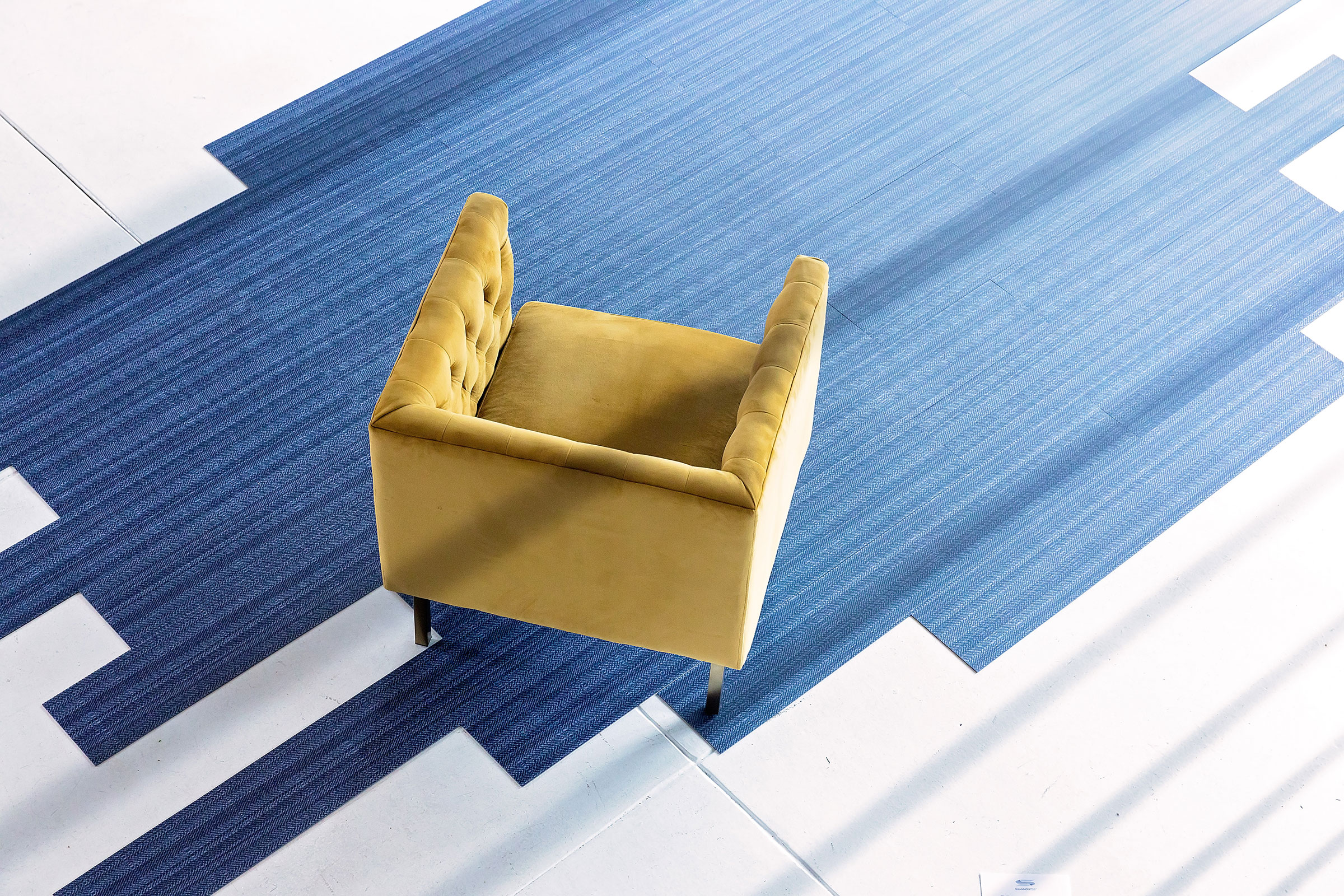
Teknoflor Icon Tile HPD brings a new dimension of design to any commercial setting. Pictured here is Denim. Photo courtesy of Teknoflor
Decades ago Teknoflor brought low-maintenance, no-wax, no-buff floors to market. Their sheet products offer heat-welded, seamless installation for easy cleaning and infection control.
“Healthy design is creating products that positively influence the health and comfort of the building occupants—that’s the main goal. And then sustainability is achieving that healthy design with a beneficial approach to the environment,” said Andrew Heeter, Teknoflor’s vice president of strategic sales, in a previous interview with gb&d.
Mondo Contract Flooring
In addition to sports facilities and educational institutions, rubber can also be an ideal flooring solution for health care spaces. Mondo Contract Flooring, for example, specializes in premium rubber flooring and points to its Natura line as a top sustainable flooring product.
Their rubber—which is highly resistant to shrinking and cracking—is also free of Red List ingredients (those building materials deemed harmful to humans and the environment). The Natura product is also free of PVCs, heavy metals, chlorine, BPA, and halogen.
Cleaning Supplies
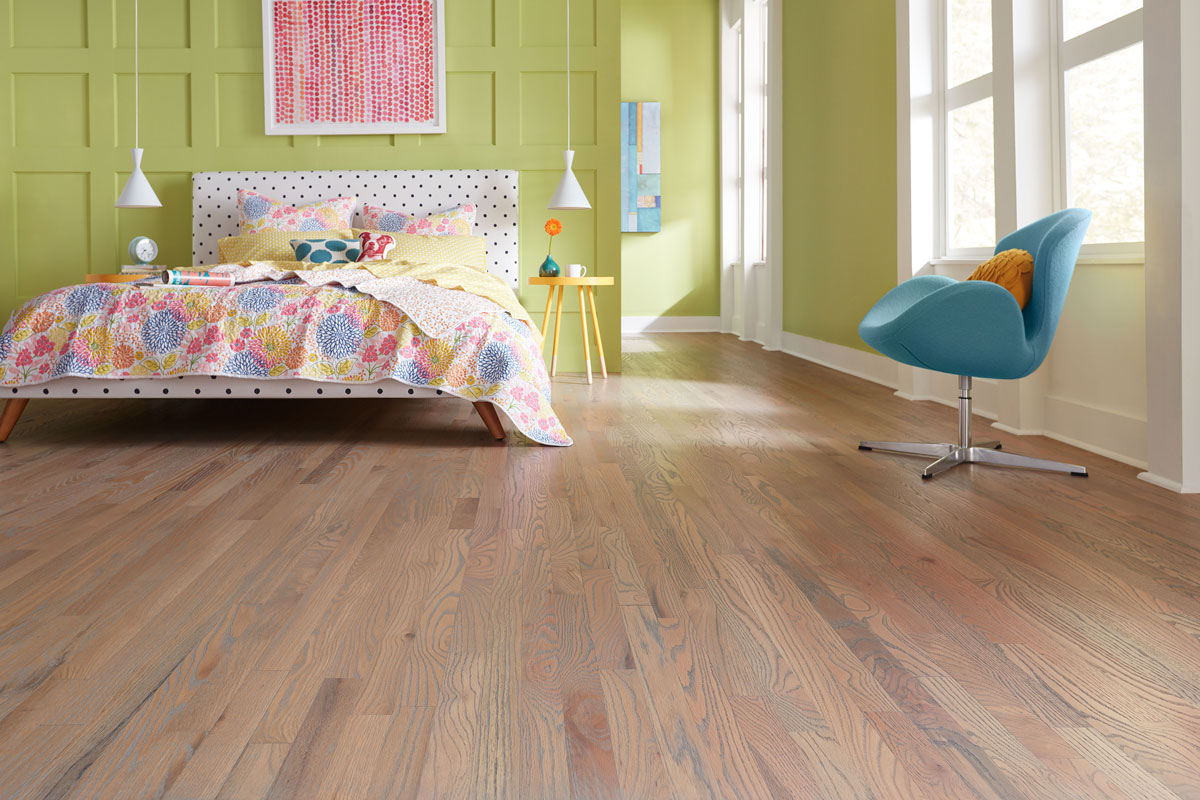
Courtesy of Bona
Beyond the material itself, it’s important to make sustainable choices when it comes to the products used to clean and maintain a project’s floors. A beautiful hardwood floor can elevate any interior, and the experts at Bona know how to keep those floors clean and looking new for a long time.
The team at Bona suggests floor finishes like theirs that are waterborne and low in VOCs—to protect the floor and the environment at large and for better indoor air quality.
Refinishing your hardwood also reduces the carbon footprint by more than 75% compared to floor replacement, according to one of their recent reports.
Laura Rote contributed to this article.

